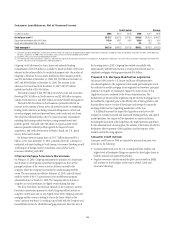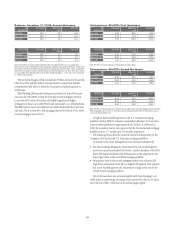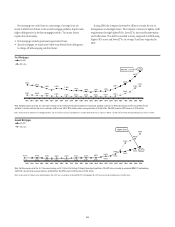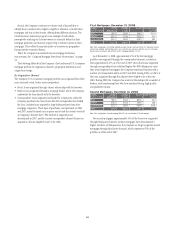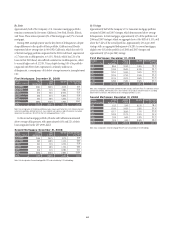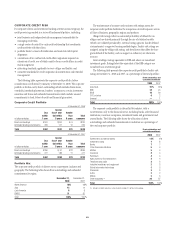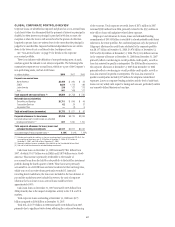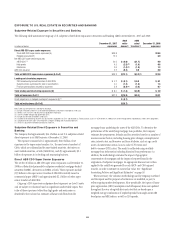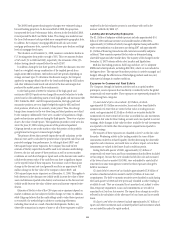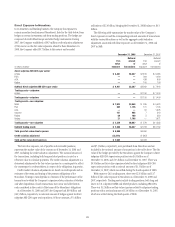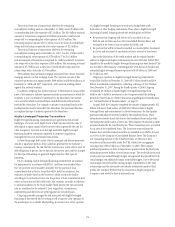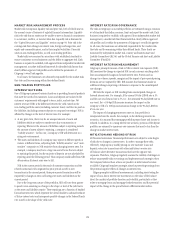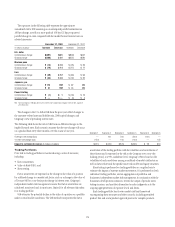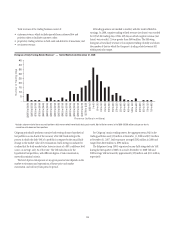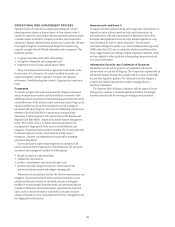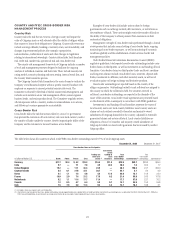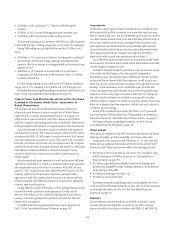Citibank 2008 Annual Report Download - page 75
Download and view the complete annual report
Please find page 75 of the 2008 Citibank annual report below. You can navigate through the pages in the report by either clicking on the pages listed below, or by using the keyword search tool below to find specific information within the annual report.The 2008 fourth quarter housing-price changes were estimated using a
forward-looking projection. In the second half of 2008, this projection
incorporated the Loan Performance Index, whereas in the first half of 2008,
it incorporated the S&P Case Shiller Index. This change was made because
the Loan Performance Index provided more comprehensive geographic data.
In addition, the Company’s mortgage default model also uses recent
mortgage performance data, a period of sharp home price declines and high
levels of mortgage foreclosures.
The valuation as of December 31, 2008, assumes a cumulative decline in
U.S. housing prices from peak to trough of 33%. This rate assumes declines
of 16% and 13% in 2008 and 2009, respectively, the remainder of the 33%
decline having already occurred before the end of 2007.
In addition, during the last three quarters of 2008, the discount rates were
based on a weighted average combination of the implied spreads from
single-name ABS bond prices, ABX indices and CLO spreads, depending on
vintage and asset types. To determine the discount margin, the Company
applies the mortgage default model to the bonds underlying the ABX indices
and other referenced cash bonds and solves for the discount margin that
produces the market prices of those instruments.
In the third quarter of 2008, the valuation of the high-grade and
mezzanine ABS CDO positions was changed from model valuation to trader
prices based on the underlying assets of each high-grade and mezzanine ABS
CDO. Unlike the ABCP- and CDO-squared positions, the high-grade and
mezzanine positions are now largely hedged through the ABX and bond
short positions, which are, by necessity, trader priced. Thus, this change
brings closer symmetry in the way these long and short positions are valued
by the Company. Additionally, there were a number of liquidations of high-
grade and mezzanine positions during the third quarter. These were at prices
close to the value of trader prices. The liquidation proceeds in total were also
above the June 30, 2008 carrying amount of the positions liquidated.
Citigroup intends to use trader marks to value this portion of the portfolio
going forward so long as it remains largely hedged.
The primary drivers that currently impact the model valuations are the
discount rates used to calculate the present value of projected cash flows and
projected mortgage loan performance. In valuing its direct ABCP- and
CDO-squared super senior exposures, the Company has made its best
estimate of the key inputs that should be used in its valuation methodology.
However, the size and nature of these positions as well as current market
conditions are such that changes in inputs such as the discount rates used to
calculate the present value of the cash flows can have a significant impact
on the reported value of these exposures. For instance, each 10 basis point
change in the discount rate used generally results in an approximate $32
million change in the fair value of the Company’s direct ABCP- and
CDO-squared super senior exposures as of December 31, 2008. This applies to
both decreases in the discount rate (which would increase the value of these
assets and decrease reported write-downs) and increases in the discount rate
(which would decrease the value of these assets and increase reported write-
downs).
Estimates of the fair value of the CDO super senior exposures depend on
market conditions and are subject to further change over time. In addition,
while Citigroup believes that the methodology used to value these exposures
is reasonable, the methodology is subject to continuing refinement,
including those made as a result of market developments. Further, any
observable transactions in respect of some or all of these exposures could be
employed in the fair valuation process in accordance with and in the
manner called for by SFAS 157.
Lending and Structuring Exposures
The $2.1 billion of subprime-related exposures includes approximately $0.1
billion of CDO warehouse inventory and unsold tranches of ABS CDOs,
approximately $1.3 billion of actively managed subprime loans purchased for
resale or securitization at a discount to par during 2007 and approximately
$1.3 billion of financing transactions with customers secured by subprime
collateral. These amounts represent the fair value as determined using
observable inputs and other market data. The majority of the change from the
December 31, 2007 balances reflects sales, transfers and liquidations.
S&B also has trading positions, both long and short, in U.S. subprime
RMBS and related products, including ABS CDOs, which are not included in
the figures above. The exposure from these positions is actively managed and
hedged, although the effectiveness of the hedging products used may vary
with material changes in market conditions.
Exposure to Commercial Real Estate
The Company, through its business activities and as a capital markets
participant, incurs exposures that are directly or indirectly tied to the global
commercial real estate market. These exposures are represented primarily by
the following three categories:
(1) Assets held at fair value include:$5.8 billion, of which
approximately $3.5 billion are securities, loans and other items linked to
commercial real estate that are carried at fair value as trading account
assets, and approximately $2.3 billion of which are securities backed by
commercial real estate carried at fair value as available-for-sale investments.
Changes in fair value for these trading account assets are reported in current
earnings, while changes in fair value for these available-for-sale investments
are reported in OCI with other-than-temporary impairments reported in
current earnings.
The majority of these exposures are classified as Level 3 in the fair-value
hierarchy. Weakening activity in the trading markets for some of these
instruments resulted in reduced liquidity, thereby decreasing the observable
inputs for such valuations, and could have an adverse impact on how these
instruments are valued in the future if such conditions persist.
During the fourth quarter of 2008, approximately $3.3 billion of
commercial real estate loans and loan commitments that had been included
in this category, because they were classified as held-for-sale and measured
at the lower-of-cost-or-market (LOCOM), were reclassified to assets held at
amortized cost since management’s intent for these exposures changed to
held for investment.
(2) Assets held at amortized cost include approximately $2.0 billion of
securities classified as held-to-maturity and $24.9 billion of loans and
commitments. The held-to-maturity securities were classified as such during
the fourth quarter of 2008 and were previously classified as either trading or
available for sale. They are accounted for at amortized cost, subject to other-
than-temporary impairment. Loans and commitments are recorded at
amortized cost, less loan loss reserves. The impact from changes in credit is
reflected in the calculation of the allowance for loan losses and in net credit
losses.
(3) Equity and other investments include approximately $4.7 billion of
equity and other investments such as limited partner fund investments which
are accounted for under the equity method.
69


